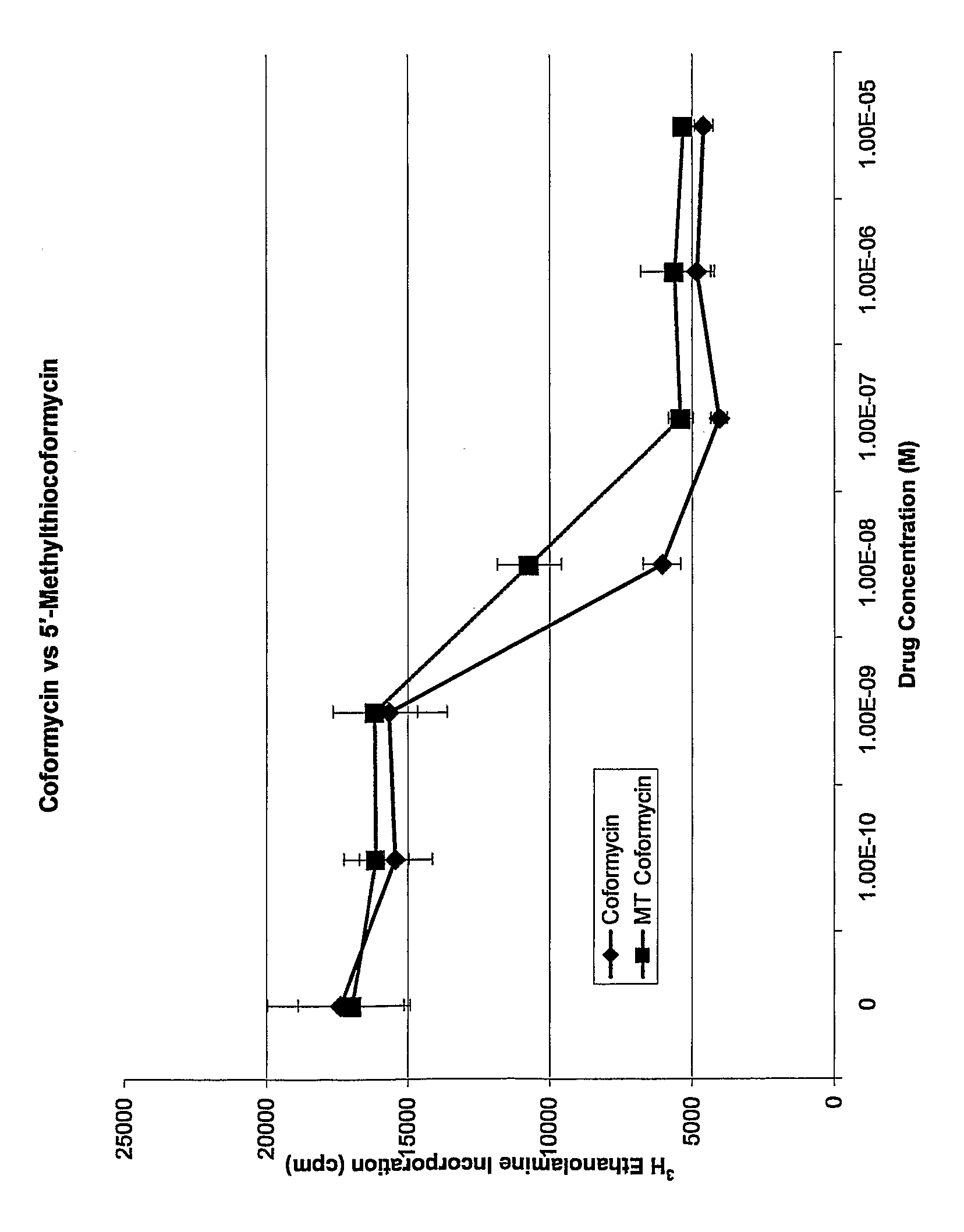Analogues of coformycin and their use for treating protozoan parasite infections
a technology of coformycin and analogues, which is applied in the field of analogues of coformycin, can solve the problems of high toxicity of deoxycoformycin in mammals
- Summary
- Abstract
- Description
- Claims
- Application Information
AI Technical Summary
Benefits of technology
Problems solved by technology
Method used
Image
Examples
example 1
Synthesis of 5′-methylthiocoformycin (8)
Example 1.1
Allyl α,β-D-ribofuranoside (1)
[0134]Acetyl chloride (4 mL) was added to a stirred suspension of D-ribose (15 g) in allyl alcohol (200 mL) whereupon the solid quickly dissolved. After 1 h pyridine (10 mL) was added and the solution was concentrated to dryness. Chromatography of the residue afforded the anomeric mixture of the title compounds 1 as a colourless syrup (18.6 g, 98%). 1H NMR (CD3OD) δ 6.0-5.84 (2H, m), 5.4-4.9 (3H, m), 4.3-3.9 (5H, m), 3.8-3.5 (2H, m); 13C NMR (peaks of the major anomer) δ 136.1, 117.6, 108.3, 85.3, 76.7, 73.2, 69.7, 65.5.
example 1.2
Allyl 5-O-p-toluenesulfonyl-α,β-D-ribofuranoside (2)
[0135]A solution of allyl α,β-D-ribofuranoside 1 (18.6 g) in dry pyridine (100 mL) was cooled in an ice bath and p toluenesulfonyl chloride (22.4 g, 1.2 eq) was added portion-wise keeping the reaction temperature 1H NMR (CDCl3) δ 7.80 (2H, d, J=8.3 Hz), 7.34 (2H, d, J=8.0 Hz), 5.85-5.72 (1H, m), 5.25-5.11 (2H, m), 4.94 (1H, s), 4.27-3.98 (6H, m), 3.87-3.80 (1H, m), 2.44 (3H, s); 13C NMR δ 145.5, 134.1, 133.0, 130.3, 128.4, 117.9, 106.6, 80.8, 75.2, 72.3, 71.0, 68.6, 22.0.
example 1.3
Allyl 2,3-di-O-acetyl-5-methylthio-α,β-D-ribofuranoside (3)
[0136]Sodium thiomethoxide (4.1 g) was added to a solution of allyl 5-O-p-toluenesulfonyl-α,β-D-ribofuranoside (2) (6.7 g) in N,N-dimethylformamide (30 mL). The resulting solution became hot and after 1 h pyridine (50 mL) and acetic anhydride (50 mL) were added and the mixture was stirred overnight at RT. Toluene (100 mL) was added and the whole was washed with water, 2M aq HCl and saturated aq NaHCO3. Normal processing afforded an anomeric mixture of the title product 3 that was separated by chromatography (4.16 g and 0.73 g, total 82%). For the less polar major component 1H NMR (CDCl3) δ 5.94-5.83 (1H, m), 5.34-5.26 (4H, m), 5.04 (1H, s), 4.30-4.19 (2H, m), 4.04-3.98 (1H, m), 2.77-2.75 (2H, m), 2.18, 2.10, 2.06 (3H each, s); 13C NMR δ 170.1, 170.0, 133.9, 117.9, 104.7, 80.8, 75.5, 74.8, 68.9, 38.8, 20.9, 16.6. For the minor more polar isomer 1H NMR (CDCl3) δ 5.95-5.84 (1H, m), 5.34-5.02 (5H, m), 4.35-4.21 (2H, m), 4.12-4.0...
PUM
| Property | Measurement | Unit |
|---|---|---|
| picomolar dissociation constants | aaaaa | aaaaa |
| dissociation constants | aaaaa | aaaaa |
| dissociation constants | aaaaa | aaaaa |
Abstract
Description
Claims
Application Information
 Login to View More
Login to View More - R&D
- Intellectual Property
- Life Sciences
- Materials
- Tech Scout
- Unparalleled Data Quality
- Higher Quality Content
- 60% Fewer Hallucinations
Browse by: Latest US Patents, China's latest patents, Technical Efficacy Thesaurus, Application Domain, Technology Topic, Popular Technical Reports.
© 2025 PatSnap. All rights reserved.Legal|Privacy policy|Modern Slavery Act Transparency Statement|Sitemap|About US| Contact US: help@patsnap.com



